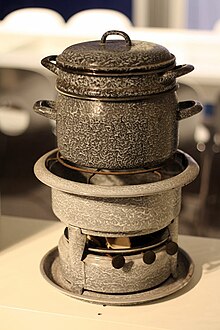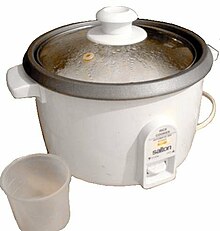Rice cooker
This article needs additional citations for verification. (January 2010) |


A rice cooker or rice steamer is an automated kitchen appliance designed to boil or steam rice. It consists of a heat source, a cooking bowl, and a thermostat. The thermostat measures the temperature of the cooking bowl and controls the heat. Complex, high-tech rice cookers may have sensors and other components, and may be multipurpose.
Naming[]
The term rice cooker formerly applied to non-automated dedicated rice-cooking utensils, which have an ancient history (a ceramic rice steamer dated to 1250 BC is on display in the British Museum). It now applies mostly to automated cookers. Electric rice cookers were developed in Japan, where they are known as suihanki (炊飯器, literally, "boil-rice-device").
Principle of operation[]

A basic rice cooker has a main body (pot), an inner cooking container which holds the rice, an electric heating element, and a thermostat.
The bowl is filled with rice and water and heated at full power; the water reaches and stays at boiling point (100 °C, 212 °F).[1] When the water has all been absorbed, the temperature can rise above boiling point, which trips the thermostat. Some cookers switch to low-power "warming" mode, keeping the rice at a safe temperature of approximately 65 °C (150 °F); simpler models switch off; the rice has entered the resting phase.
More advanced cookers may use fuzzy logic for more detailed temperature control, induction rather than resistive heating, a steaming tray for other foods, and even the ability to rinse the rice.[1]

Rice types and rice cookers[]
Brown rice generally needs longer cooking times than white rice, unless it is broken, or flourblasted (which perforates the bran).[2]
Many models feature an ability to cook sticky rice or porridge as an added value. Most can be used as steamers. Some can be used as slow cookers. Some other models can bake bread or in some cases have an added function to maintain temperatures suitable for fermentation of bread dough or yogurt. Multi-purpose devices with rice cooking capability are not necessarily called "rice cookers", but typically "multi-cookers".[3]
A rice cooker, or slow cooker, can be used in conjunction with a temperature probe and an external thermostat to cook food at a stable low temperature ("sous-vide").[4]
History[]

Automatic electric rice cookers were first released in 1955 by the Japanese company Toshiba.[5] In December 1956, the Toshiba Corporation placed the first commercially successful automated electric rice cookers on the market.[6] Since then, millions have been sold worldwide. The rice cookers available today are not much different from the original models.
The first practical electric rice cooker was invented by .[7][8]

See also[]
- Rice polisher
- Slow cooker
- Remoska, small portable oven
- Vacuum flask
- Hot water dispenser
- Zojirushi Corporation
- Tiger Corporation
- Rinnai Corporation
- List of cooking appliances
- List of Japanese cooking utensils
References[]
- ^ Jump up to: a b "Rice Cooker Basics". How Stuff Works. Retrieved 10 February 2019.
- ^ ars.usda.gov Agriculture Research, May 2002
- ^ Kate Hilpern (21 September 2018). "9 best multi-cookers". The Independent. Retrieved 10 February 2019.
- ^ Gabrielle Taylor (5 September 2013). "How to Cook Food Perfectly at Home with a Super Cheap DIY Sous Vide Machine". Food Hacks. Retrieved 10 February 2019.
- ^ "IH Jar Rice Cooker: The Special Duty-Free Website Toshiba Living Doors". www.toshiba-lifestyle.co.jp. Retrieved 2021-03-11.
- ^ "Toshiba Firsts Of Their Kind". Toshiba Corp. Museum. Archived from the original on 2011-10-05. Retrieved 2010-03-14.
- ^ Ewbank, Anne (2020-07-31). "The Battle to Invent the Automatic Rice Cooker". Atlas Obscura. Retrieved 2021-07-27.
- ^ "Japan's First Automatic Electric Rice Cooker". Toshiba Science Museum.
Further reading[]
| Wikimedia Commons has media related to Rice cooker. |
| Wikibooks Cookbook has a recipe/module on |
- Nakano, Yoshiko (2009), Where There Are Asians, There Are Rice Cookers: How 'National' Went Global via Hong Kong, Hong Kong University Press, ISBN 978-988-8028-08-5
- Rice
- Chinese food preparation utensils
- Cooking appliances
- Cooking vessels
- Cookware and bakeware
- East Asian food preparation utensils
- Japanese food preparation utensils
- Japanese inventions
- Korean food preparation utensils